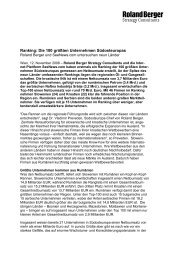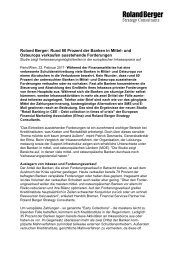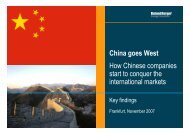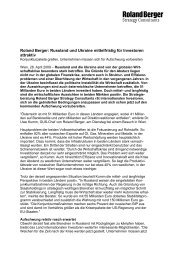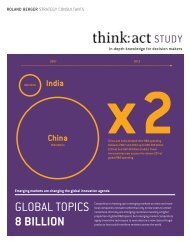Top Management Issues Radar 2012 - Roland Berger
Top Management Issues Radar 2012 - Roland Berger
Top Management Issues Radar 2012 - Roland Berger
Create successful ePaper yourself
Turn your PDF publications into a flip-book with our unique Google optimized e-Paper software.
SURVEY<br />
<strong>Top</strong> <strong>Management</strong> <strong>Issues</strong> <strong>Radar</strong> <strong>2012</strong><br />
European Aerospace & Defence industry
ROLAND BERGER STRATEGY CONSULTANTS<br />
WHY PRODUCE A TOP MANAGEMENT ISSUES RADAR?<br />
As a top strategy consultancy in the European Aerospace & Defence sector,<br />
<strong>Roland</strong> <strong>Berger</strong> Strategy Consultants actively supports industry leaders in<br />
identifying challenges, uncovering solutions and driving decisive change in<br />
their organizations<br />
In 2008 we identified a growing need for dialogue amongst senior executives<br />
regarding the key issues that affect the industry. Therefore, we launched a<br />
«<strong>Top</strong> <strong>Management</strong> <strong>Issues</strong> <strong>Radar</strong>» to support executive-level thinking across<br />
the European Aerospace & Defence industry<br />
The latest survey was conducted between March and April <strong>2012</strong>, involving<br />
more than 100 senior industry executives and representing a broad range<br />
of segments and positions in the value chain. The survey captured prevailing<br />
trends on two hot topics:<br />
> Globalization of markets: how do A&D players intend to develop business<br />
outside Western Europe?<br />
> Globalization of operations: how do they intend to develop design and<br />
production capabilities abroad?<br />
Here are our conclusions. We trust you will find them insightful and relevant<br />
to your strategic thinking and decision making. We would welcome the<br />
opportunity to have a more detailed discussion directly with you on any of<br />
the issues presented.<br />
The European Aerospace & Defence<br />
practice management team<br />
Georgy Babilashvily (Moscow)<br />
Sébastien Cailliau (Brussels)<br />
Roberto Crapelli (Milan)<br />
Martin Eisenhut (Munich)<br />
Didier Gobin (Paris)<br />
François Guenard (Paris)<br />
Manfred Hader (Hamburg)<br />
Juergen Liedl (Berlin)<br />
Alberto De Monte (Rome)<br />
Alain d’Oultremont (Brussels)<br />
Mathieu Pacault (Paris)<br />
Philippe Plouvier (Paris)<br />
Jérôme Rein (Paris)<br />
Ali Rekik (Paris)<br />
Paul Sloman (London)<br />
Robert Thomson (London)<br />
Didier Tshidimba (Brussels)<br />
Michel Vlasselaer (Brussels)<br />
Joerg Wahler (Stuttgart)<br />
1
TOPICS<br />
a. COMPANY AGENDAS IN 2011<br />
b.<br />
c.<br />
d.<br />
DEVELOPING BUSINESS OUTSIDE WESTERN EUROPE<br />
DEVELOPING DESIGN AND PRODUCTION CAPABILITIES<br />
OUTSIDE EUROPE<br />
VISION OF THE A&D BUSINESS ENVIRONMENT IN 2015<br />
3
ROLAND BERGER STRATEGY CONSULTANTS<br />
a. Company agendas in <strong>2012</strong><br />
FOR THE FIRST TIME, MANUFACTURING AND SUPPLY CHAIN ARE THE TOP CONCERNS FOR SENIOR<br />
EUROPEAN A&D EXECUTIVES<br />
TOP PRIORITY IN COMPANY'S AGENDA<br />
[4 MOST FREQUENT ANSWERS]<br />
2008 2009 2010 2011<br />
<strong>2012</strong><br />
RATIONALE AND INDUSTRY TREND<br />
Manufacturing and Supply Chain are for the first time the top concerns for<br />
European A&D decision makers<br />
#1<br />
Programme<br />
<strong>Management</strong><br />
Programme<br />
<strong>Management</strong><br />
Programme<br />
<strong>Management</strong><br />
Programme<br />
<strong>Management</strong><br />
Manufacturing<br />
Despite the financial crisis, many A&D companies are enjoying historic order<br />
book levels that ensure capacity engagement for several years ahead<br />
#2<br />
Market<br />
Strategy/<br />
Globalisation<br />
Market<br />
Strategy/<br />
Globalisation<br />
Market<br />
Strategy/<br />
Globalisation<br />
Market<br />
Strategy/<br />
Globalisation<br />
Supply<br />
Chain<br />
Securing on-time delivery in line with production plans has turned into a short<br />
term challenge as several major civil and military programmes are moving from<br />
development to industrialization or early series production phase<br />
Stakes are high for most players, who need<br />
> To establish or restore credibility vs. poor ramp-up performance in the past<br />
#3<br />
#4<br />
Supply<br />
Chain<br />
External<br />
Growth/PMI<br />
Flexibility<br />
Marketing<br />
& Sales<br />
Product<br />
Strategy<br />
Supply<br />
Chain<br />
Innovation<br />
and R&D<br />
efficiency<br />
Supply<br />
Chain<br />
Market<br />
Strategy/<br />
Globalisation<br />
Programme<br />
<strong>Management</strong><br />
> To reduce recurring costs to compensate for cost overruns during<br />
>>development phases<br />
Market Strategy/ Globalisation remains a top priority in light of increasing<br />
global competition. Most companies are planning to sustain their growth<br />
initiatives both in terms of product/ service portfolio extension and geographic<br />
expansion, as explored in <strong>2012</strong> survey<br />
Source: <strong>Roland</strong> <strong>Berger</strong> "<strong>Top</strong> <strong>Management</strong> <strong>Issues</strong> radar <strong>2012</strong>" Survey<br />
4
ROLAND BERGER STRATEGY CONSULTANTS<br />
a. Company agendas in <strong>2012</strong><br />
TWO THIRDS OF RESPONDENTS CONSIDER THEIR COMPANY READY TO COPE WITH DELIVERY RATE<br />
INCREASE AND NEW PROGRAMME RAMP-UPS<br />
READINESS TO COPE WITH DELIVERY RATE INCREASE<br />
AND NEW PROGRAMMES RAMP-UPS<br />
[% ANSWERS]<br />
RATIONALE AND INDUSTRY TREND<br />
With order books at historic levels, most Prime contractors and Tier-1 suppliers<br />
have anticipated ramp-up challenges and have launched initiatives to get prepared,<br />
mainly<br />
> Capacity investments<br />
> Manufacturing efficiency new projects<br />
NO<br />
32%<br />
68%<br />
YES<br />
Schedule drifts of major development programmes and delayed industrial rampups<br />
(e.g. due to government pressure to slow-down the delivery rate of military<br />
products) have also provided further capacity and time for preparation<br />
Nevertheless major uncertainties remain<br />
Actual maturity/manufacturability of the new product designs (e.g. composite), was<br />
stated last year as n°1 key success factor for ramp-up<br />
Readiness of Tier-2 suppliers to ramp-up (investments capacity limited compared to<br />
Prime contractors and Tier-1 suppliers)<br />
Readiness of new suppliers, e.g. in emerging countries (capacity and capabilities<br />
not yet demonstrated)<br />
Availability of raw material (e.g. forging, carbon fiber)<br />
Source: <strong>Roland</strong> <strong>Berger</strong> "<strong>Top</strong> <strong>Management</strong> <strong>Issues</strong> radar <strong>2012</strong>" Survey<br />
5
ROLAND BERGER STRATEGY CONSULTANTS<br />
a. Company agendas in <strong>2012</strong><br />
MOST COMPANIES PLAN TO SUSTAIN THEIR GROWTH INITIATIVES BOTH IN TERMS OF<br />
PRODUCT/SERVICE PORTFOLIO EXTENSION AND GEOGRAPHIC EXPANSION<br />
GROWTH INITIATIVES SUSTAINED VS. LAST YEAR<br />
[% ANSWERS]<br />
RATIONALE AND INDUSTRY TREND<br />
NO<br />
100%<br />
12%<br />
100%<br />
13%<br />
The return of growth to the top of the agenda in 2011 had been a<br />
significant change vs. the previous years when companies were still<br />
focused on reorganization and cost containment<br />
Growth remains a top priority in companies’ agendas in <strong>2012</strong> with<br />
motivations including:<br />
> Meet ambitious targets set by shareholders>><br />
YES<br />
88%<br />
87%<br />
> Increase the geographic proximity to customers>><br />
> Diversify into non-cyclical businesses and compensate for the >>weakness<br />
of some domestic markets (e.g. defence)<br />
<strong>2012</strong> survey confirms companies’ willingness to grow both in terms of<br />
Broader product /<br />
service portfolio<br />
Geographic<br />
expansion<br />
> Product/service portfolio extension: mainly new product / services for the<br />
market segments currently addressed, but also penetration of new A&D<br />
market segments<br />
> Geographic expansion, as detailed in the following pages<br />
Source: <strong>Roland</strong> <strong>Berger</strong> "<strong>Top</strong> <strong>Management</strong> <strong>Issues</strong> radar <strong>2012</strong>" Survey<br />
6
ROLAND BERGER STRATEGY CONSULTANTS<br />
b. Developing business outside Western Europe<br />
ALMOST HALF OF COMPANIES INTERVIEWED AIM TO DERIVE 60%+ OF THEIR REVENUES<br />
FROM OUTSIDE WESTERN EUROPE<br />
COMPANIES TARGETING MORE<br />
THAN 60% OF BUSINESS OUTSIDE<br />
WESTERN EUROPE<br />
[% ANSWERS]<br />
24%<br />
43%<br />
TOP EXECUTIVE INSIGHTS<br />
"Although the economic environment worsened<br />
more markedly than expected, particularly in<br />
defence, our order intake increased and our<br />
revenues held up well. A marked upturn in our<br />
results is now underway, driven by […] our<br />
stronger footprint in growth regions "<br />
L. Vigneron, CEO Thales<br />
(company release, March <strong>2012</strong>)<br />
"Sagem targets € 2b revenues in the mid-term<br />
vs. € 1.26b in 2011 by increasing the share of its<br />
export business whose share is already 60%<br />
today"<br />
P. Petitcolin – CEO Sagem<br />
(Reuters / Eurosatory, June <strong>2012</strong>)<br />
RATIONALE AND INDUSTRY TREND<br />
Business development outside Western Europe is<br />
an immediate action in order to:<br />
> React to drastic cuts in European governmental<br />
budgets<br />
> Compensate cost reduction efforts driven by<br />
European civil clients/ operators<br />
> Capture opportunities on new programmes in<br />
emerging markets (e.g. C919, MS-21, KC390…)<br />
It also supports the mid-term strategy of most<br />
Western players who intend to:<br />
> Balance their portfolio of customers, as a risk<br />
mitigation<br />
> Secure long-terms positions in emerging markets<br />
Current<br />
Target<br />
"In the future, Cassidian aims to generate some<br />
50% of its revenues outside Europe"<br />
S. Zoller – CEO Cassidian<br />
(Süddeutsche Zeitung, Feb. <strong>2012</strong>)<br />
Source: <strong>Roland</strong> <strong>Berger</strong> "<strong>Top</strong> <strong>Management</strong> <strong>Issues</strong> radar <strong>2012</strong>" Survey, Press, Company communication<br />
7
ROLAND BERGER STRATEGY CONSULTANTS<br />
b. Developing business outside Western Europe<br />
NORTH AMERICA IS SEEN AS THE MOST ATTRACTIVE AREAS FOR BUSINESS OUTSIDE<br />
WESTERN EUROPE; FOLLOWED BY CHINA AND SOUTH AMERICA (BRAZIL)<br />
MOST ATTRACTIVE AREAS FOR BUSINESS OUTSIDE<br />
WESTERN EUROPE [% ANSWERS]<br />
MAIN CHALLENGES IN ADDRESSING MARKET OUSIDE<br />
WESTERN EUROPE [% APPEARANCE IN TOP 3 ANSWERS]<br />
North America<br />
China<br />
19%<br />
26%<br />
North America, China and South America (inc. Brazil) appear as the most<br />
attractive areas to develop revenues outside Western Europe, as detailed in the<br />
following pages<br />
India and Russia are disregarded despite apparent business potential<br />
South America (incl. Brazil)<br />
Asia (excl. China)<br />
Middle East<br />
India<br />
Russia<br />
14%<br />
13%<br />
11%<br />
9%<br />
6%<br />
India<br />
> World’s largest arms importer (10% of global arms imports in 2007-2011)<br />
> But (a) high offset demands (30% to 50%), (b) complex decision-making/<br />
difficulty to secure decision enforcement and (c) privileged relationship<br />
with non-Western countries such as Russia<br />
Russia<br />
> Several major new programmes (MS-21, 5th generation fighter, …) and major<br />
>>military investment programme (~€ 490b for <strong>2012</strong>-2020)<br />
> But (a) difficulty of understanding local business rules and ways of working,<br />
>>(b) strong national preference policy (c) significant concerns regarding<br />
Intellectual Property protection<br />
Eastern and Central Europe<br />
2%<br />
Source: <strong>Roland</strong> <strong>Berger</strong> "<strong>Top</strong> <strong>Management</strong> <strong>Issues</strong> radar <strong>2012</strong>" Survey, SIPRI, Press<br />
8
ROLAND BERGER STRATEGY CONSULTANTS<br />
b. Developing business outside Western Europe<br />
RESPONDING COMPANIES AIM TO DEVELOP CIVIL & MILITARY, PRODUCT AND SERVICES<br />
REVENUES OUTSIDE WESTERN EUROPE<br />
TYPE OF BUSINESS TARGETED [% ANSWERS]<br />
NORTH AMERICA BRAZIL CHINA<br />
Military<br />
100%<br />
10%<br />
Services<br />
100%<br />
8%<br />
Military<br />
100%<br />
10%<br />
Services<br />
100%<br />
7%<br />
Military<br />
Both<br />
100%<br />
5% 0%<br />
Services<br />
100%<br />
9%<br />
Both<br />
53%<br />
Both<br />
55%<br />
Both<br />
53%<br />
Both<br />
47%<br />
Both<br />
44%<br />
Civil<br />
95%<br />
Civil<br />
37%<br />
Product<br />
37%<br />
Civil<br />
37%<br />
Product<br />
46%<br />
Product<br />
47%<br />
Segments<br />
Portfolio<br />
Segments<br />
Portfolio<br />
Segments<br />
Portfolio<br />
The US military market still appears attractive for:<br />
> European primes despite the slow down in<br />
spending since 2008, as US military expenditures<br />
remain two times higher than in Western Europe<br />
where further budget cuts are expected<br />
> European tier-1 or sub-tier suppliers as 8 out of the<br />
10 largest defence-equipment producing<br />
companies are US based<br />
Embraer is becoming a major player, including in the<br />
military business (e.g. KC390)<br />
More globally, Brazil’s attractiveness results from its<br />
growth outlook, including increase in its military<br />
spending (ambition to become the local leader,<br />
necessity to address threats from Venezuela and<br />
drug traffic)<br />
China still shows a steady growth outlook in the civil<br />
business<br />
> Strong business drivers (GDP, internal passenger<br />
traffic…)<br />
> New major programmes to come (e.g. Long<br />
Range)<br />
> Favorable changes in regulation (e.g. liberalization<br />
of low altitude space expected to boost demand for<br />
helicopters and business jets)<br />
Source: <strong>Roland</strong> <strong>Berger</strong> "<strong>Top</strong> <strong>Management</strong> <strong>Issues</strong> radar <strong>2012</strong>" Survey, SIPRI<br />
9
ROLAND BERGER STRATEGY CONSULTANTS<br />
b. Developing business outside Western Europe<br />
THE IMPORTANCE OF «TECHNOLOGY AND KNOW-HOW TRANSFER» AS A BUYING<br />
CRITERIA TENDS TO INCREASE AS LOCAL INDUSTRIAL MATURITY DECREASES<br />
MOST IMPORTANT FACTOR IN WINNING NEW BUSINESS [% ANSWERS]<br />
NORTH AMERICA BRAZIL CHINA<br />
Other<br />
Technology know-how transfer<br />
Offset<br />
100%<br />
6%<br />
7%<br />
1%<br />
Other<br />
Technology know-how transfer<br />
100%<br />
4%<br />
30%<br />
Other<br />
100%<br />
10%<br />
Product/service performance<br />
74%<br />
Offset<br />
14%<br />
Technology know-how transfer<br />
66%<br />
HIGH<br />
Price<br />
12%<br />
« Value for Money » and « Total Cost of Ownership »<br />
approaches promoted by the DoDs and major civil customers/<br />
operators set<br />
« Product /service performance » as the primary business Key<br />
Success Factor<br />
Source: <strong>Roland</strong> <strong>Berger</strong> "<strong>Top</strong> <strong>Management</strong> <strong>Issues</strong> radar <strong>2012</strong>" Survey<br />
10<br />
Product/service performance<br />
Price<br />
38%<br />
14%<br />
INDUSTRIAL MATURITY<br />
Offset<br />
Product/service performance<br />
Price<br />
16%<br />
7%<br />
1%<br />
LOW<br />
« Technology and know-how transfer » is the most important<br />
contributor to winning new businesses when a country still<br />
intends to develop its own technological base, in particular in<br />
the military business
ROLAND BERGER STRATEGY CONSULTANTS<br />
b. Developing business outside Western Europe<br />
DEVELOPING AN UNDERSTANDING OF THE LOCAL RULES OF THE GAME AND A LOCAL<br />
POLITICAL SUPPORT ARE THE KEYS TO ADDRESS MARKETS ABROAD<br />
MAIN CHALLENGES IN ADDRESSING MARKET OUTSIDE<br />
WESTERN EUROPE [% APPEARANCE IN TOP 3 ANSWERS]<br />
RATIONALE AND INDUSTRY TREND<br />
Developing knowledge/<br />
understanding local rules of game<br />
Developing local political support<br />
Developing local design<br />
or production capabilities<br />
Adapting organizations and<br />
ways of working<br />
Customizing products/service features<br />
to local customer requirements<br />
Mobilizing financial resources<br />
Other<br />
2%<br />
4%<br />
21%<br />
15%<br />
11%<br />
11%<br />
36%<br />
Developing an understanding of the local rules of the game and<br />
local political support are perceived as the keys to creating client<br />
intimacy, overcoming local entry barriers and in the end succeeding<br />
in addressing markets abroad<br />
A&D companies are indeed drawing lessons learnt from the failure of<br />
standardized approaches to new markets they have traditionally<br />
deployed<br />
As a result, most A&D companies tend to set up local organizations<br />
to increase proximity with local decision makers<br />
« The formation of Selex Sistemi Integrati do Brazil is consistent with<br />
the Finmeccanica Group’s internationalisation strategy, leading to the<br />
creation of a local organisation [..] »<br />
Company communication (May 2011)<br />
« The Head of local subsidiaries are accountable for their portfolio of<br />
customers. The Parisian Head-Quarter no longer decides »<br />
L. Vigneron, CEO Thales (Le Figaro, Feb. <strong>2012</strong>)<br />
« Cassidian is based on country organisations »<br />
Company communication<br />
Source: <strong>Roland</strong> <strong>Berger</strong> "<strong>Top</strong> <strong>Management</strong> <strong>Issues</strong> radar <strong>2012</strong>" Survey, Press, Company communication<br />
11
ROLAND BERGER STRATEGY CONSULTANTS<br />
b. Developing business outside Western Europe<br />
«A JOINT VENTURE/PARTNERSHIP WITH A LOCAL COMPANY» IS THE MOST EFFICIENT<br />
EXPANSION OPTION OUTSIDE THE US; WHERE A «LOCAL SUBSIDIARY» IS OPTIMAL<br />
MOST EFFICIENT DEVELOPMENT MECHANISM<br />
[% ANSWERS]<br />
UNITED STATES<br />
41%<br />
27%<br />
14% 14%<br />
1% 3%<br />
1<br />
2<br />
BRAZIL<br />
42%<br />
25% 24%<br />
1<br />
3<br />
2<br />
1 Local sales representation<br />
4<br />
3<br />
2 Local subsidiary<br />
5<br />
1%<br />
4<br />
3 Joint venture/partnership with local company<br />
6<br />
6%<br />
5<br />
1%<br />
6<br />
MIDDLE EAST<br />
38%<br />
1<br />
11%<br />
2<br />
40%<br />
3<br />
RUSSIA<br />
39% 42%<br />
1<br />
2%<br />
4<br />
11%<br />
2<br />
5%<br />
5<br />
4 Joint venture/partnership European company<br />
5 Acquisition<br />
6 Other<br />
3<br />
5%<br />
6<br />
5%<br />
4<br />
0%<br />
5<br />
3%<br />
6<br />
CHINA<br />
11% 14%<br />
1<br />
2<br />
65%<br />
3<br />
3%<br />
4<br />
2%<br />
5<br />
6%<br />
6<br />
RATIONALE AND INDUSTRY TREND<br />
JV / partnership with local company is<br />
highlighted as the preferred approach by half<br />
of respondents for all countries, as:<br />
> Local JVs / partnerships can support quick<br />
step changes<br />
> Several European players are not able to<br />
mobilize further human resources for growth<br />
(e.g. scarce profiles focused on current<br />
developments)<br />
> They enable foreign companies to overcome<br />
some entry barriers (see previous page)<br />
The relevance of local JVs / partnerships<br />
appears the greatest in China, which is still<br />
eager to partner with Western companies<br />
> To fulfill immediate needs<br />
> To support its long term strategy for<br />
technology acquisition and self-sustainability<br />
Source: <strong>Roland</strong> <strong>Berger</strong> "<strong>Top</strong> <strong>Management</strong> <strong>Issues</strong> radar <strong>2012</strong>" Survey, Press, Company communication<br />
12
ROLAND BERGER STRATEGY CONSULTANTS<br />
c. Developing design and production capabilities outside Europe<br />
NORTH AMERICA AND INDIA ARE THE MOST ATTRACTIVE DESTINATIONS FOR<br />
COMPANIES LOOKING TO DEVELOP DESIGN CAPABILITIES ABROAD<br />
DESIGN CAPABILITIES<br />
RATIONALE AND INDUSTRY TREND<br />
COMPANIES WITH MORE<br />
THAN 30% OF CAPABILITIES<br />
OUTSIDE WESTERN EUROPE<br />
[% ANSWERS]<br />
43%<br />
REASONS<br />
[% ANSWERS]<br />
Other<br />
Flexibility<br />
Entry into<br />
new markets<br />
Access to available<br />
competencies<br />
100%<br />
4%<br />
10%<br />
18%<br />
19%<br />
MOST ATTRACTIVE AREAS<br />
[% ANSWERS]<br />
Russia<br />
South America<br />
China<br />
Asia (exc. China)<br />
Central/<br />
Eastern Europe<br />
100%<br />
6%<br />
6%<br />
7%<br />
9%<br />
9%<br />
Responding companies intend to develop<br />
Design capabilities in a limited number of<br />
target countries to achieve a local critical mass<br />
of skills and competencies<br />
Target areas are English-speaking countries,<br />
with historical design experience<br />
India is now moving upmarket and provides<br />
advanced Design capabilities (e.g. modelling/<br />
simulation) on top of ‘design commodities’<br />
(software verification, detailed drawing<br />
releases…)<br />
15%<br />
Customer<br />
requirements<br />
Cost<br />
competitiveness<br />
24%<br />
25%<br />
India<br />
North America<br />
30%<br />
33%<br />
Major A&D companies are developing their<br />
own capabilities or urging their legacy<br />
suppliers to do so: «Airbus works directly with<br />
Indian companies in the design and<br />
manufacture of aero structures and strongly<br />
encourages its major Tier 1 partners to do so<br />
as appropriate» – Company communication<br />
Current<br />
Target<br />
Source: <strong>Roland</strong> <strong>Berger</strong> "<strong>Top</strong> <strong>Management</strong> <strong>Issues</strong> radar <strong>2012</strong>" Survey, Company communication<br />
13
ROLAND BERGER STRATEGY CONSULTANTS<br />
c. Developing design and production capabilities outside Europe<br />
COMPANIES ARE DEVELOPING PRODUCTION CAPABILITIES IN NORTH AMERICA AND<br />
CHINA TO IMPROVE COST COMPETITIVENESS AND MARKET ACCESS (OFFSET)<br />
PRODUCTION CAPABILITIES<br />
RATIONALE AND INDUSTRY TREND<br />
COMPANIES WITH MORE<br />
THAN 30% OF CAPABILITIES<br />
OUTSIDE WESTERN EUROPE<br />
[% ANSWERS]<br />
30%<br />
62%<br />
REASONS<br />
[% ANSWERS]<br />
Other<br />
Access to available<br />
competencies<br />
Flexibility<br />
Access to available<br />
competencies<br />
Customer<br />
requirements<br />
100%<br />
4%<br />
4%<br />
14%<br />
21%<br />
21%<br />
MOST ATTRACTIVE AREAS<br />
[% ANSWERS]<br />
Russia<br />
Central/<br />
Eastern Europe<br />
South America<br />
Asia (exc. China)<br />
India<br />
North America<br />
100%<br />
3%<br />
9%<br />
13%<br />
15%<br />
17%<br />
21%<br />
China appears as a priority development area<br />
for companies intending to enter the local<br />
market (offset) and seeking «low cost»<br />
production. However «low cost» motivation<br />
could be tempered by<br />
> The increase of production costs (average<br />
wage increase of 22% in 2011)<br />
> The production transfer costs frequently being<br />
underestimated (longer time to transfer and<br />
reach Western quality standards)<br />
US is a priority development area for companies<br />
intending to increase their dollar-cost base and<br />
develop the «made in US» brand required to<br />
access the local market (e.g. Airbus decision to<br />
set up an assembly line in Alabama)<br />
Cost<br />
competitiveness<br />
36%<br />
China<br />
22%<br />
Current<br />
Target<br />
Source: <strong>Roland</strong> <strong>Berger</strong> "<strong>Top</strong> <strong>Management</strong> <strong>Issues</strong> radar <strong>2012</strong>" Survey, Press<br />
14
ROLAND BERGER STRATEGY CONSULTANTS<br />
c. Developing design and production capabilities outside Europe<br />
THE ASSESSMENT / DEVELOPMENT OF LOCAL MANAGEMENT AND TECHNICAL TEAMS'<br />
SKILLS IS THE TOP CHALLENGE WHEN SETTING-UP AN INTERNAL CAPABILITY ABROAD<br />
INTERNAL CAPABILITIES (MAKE)<br />
RATIONALE AND INDUSTRY TREND<br />
AVERAGE LEAD-TIME FOR ESTABLISHING A MATURE<br />
INTERNAL CAPABILITY ABROAD (DESIGN OR PRODUCTION)<br />
[% OF ANSWERS]<br />
>5 years<br />
100%<br />
12%<br />
Green and brown field approaches are equally preferred for establishing<br />
internal capabilities (resp. 51% and 49% of answers). The selection of an<br />
approach seems primarily driven by constraints according to respondents<br />
> Existence of local capabilities, 'value for money' of potential targets<br />
> Local regulations preventing or favouring acquisitions<br />
The assessment and development of the skills of the local management and<br />
technical teams is quoted as the top challenge while establishing a new<br />
capability (25% of answers). The topic appears all the more critical as local<br />
skills / proficiency levels drive the performance of the new entity, but impact<br />
also domestic activities (European senior profiles used to develop local<br />
teams)<br />
2-5 years<br />
ROLAND BERGER STRATEGY CONSULTANTS<br />
c. Developing design and production capabilities outside Europe<br />
ASSESSING THE CAPACITY AND CAPABILITIES OF POTENTIAL PARTNERS IS THE TOP<br />
CHALLENGE WHILE DEVELOPING AN EXTERNAL CAPABILITY ABROAD<br />
EXTERNAL CAPABILITIES (BUY)<br />
RATIONALE AND INDUSTRY TREND<br />
AVERAGE LEAD-TIME FOR ESTABLISHING A MATURE<br />
EXTERNAL CAPABILITY ABROAD (DESIGN OR PRODUCTION)<br />
[% OF ANSWERS]<br />
>5 years<br />
100%<br />
17%<br />
Although standard approaches exist, assessing the capacity and capabilities<br />
of potential partners is the major challenge while developing an external<br />
capability (28% of answers). From our experience, common difficulties<br />
include:<br />
> The limited visibility on actual workloads and competences: internal (e.g.<br />
production line or shared work centre), but even more external (suppliers /<br />
sub-contractors)<br />
> The lack of common standards in emerging countries: demonstrated<br />
capacity for local business, not necessarily achievable while complying with<br />
Western quality standards<br />
> The difficulty of extrapolating forecasts from pilot phases (scale effects, less<br />
management attention than during pilot, …)<br />
2-5 years<br />
ROLAND BERGER STRATEGY CONSULTANTS<br />
d. Vision of the A&D business environment in 2015<br />
LOOKING AT THE FUTURE, DECLINING BUDGETS ARE THE MAIN CONCERN IN THE DEFENCE<br />
SECTOR, WHILE CIVIL SEGMENTS WILL FACE MULTIPLE CHALLENGES IN THE FIELD OF DELIVERY<br />
KEY CHALLENGES FACING THE CIVIL SECTOR<br />
[% ANSWERS]<br />
Funding availability<br />
Cost<br />
competitiveness 8%<br />
Competition<br />
19%<br />
9%<br />
19%<br />
Growing complexity<br />
in Supply Chain<br />
25%<br />
20%<br />
Ramp-up<br />
(incl. product<br />
maturity)<br />
External<br />
economic<br />
influences<br />
<strong>Top</strong> challenges quoted in the civil sector highlight a balanced focus between<br />
> External topics (competition, overall economic context)<br />
> Internal concerns (supply-chain and ramp-up management) mainly driven<br />
by the necessity to turn historical backlogs into profitable deliveries<br />
Source: <strong>Roland</strong> <strong>Berger</strong> "<strong>Top</strong> <strong>Management</strong> <strong>Issues</strong> radar <strong>2012</strong>" Survey<br />
KEY CHALLENGES FACING THE DEFENCE SECTOR<br />
[% ANSWERS]<br />
2% Rules & regulations<br />
Ramp-up 2%<br />
2% Technology<br />
Cost competitiveness 2%<br />
Relocation & transfer<br />
5%<br />
Delays<br />
7%<br />
Competition 12%<br />
68%<br />
Reduced<br />
government<br />
spending -<br />
shrinking<br />
market<br />
Business / sales perspectives are by far the main concern of companies<br />
active in the military sector due to<br />
> Declining government funding / lack of visibility of long term funding<br />
(political indecision and procurement disruption) in Western countries<br />
> The subsequent fierce competition in export markets now targeted by all<br />
Western players<br />
17
ROLAND BERGER STRATEGY CONSULTANTS<br />
d. Vision of the A&D business environment in 2015<br />
ALTHOUGH SERVICES BUSINESS IS TARGETED, OPERATIONAL CHALLENGES KEEP<br />
PUSHING THAT TOPIC AT LOW POSITIONS IN OUR RANKING<br />
INTENTION TO DEVELOP THE<br />
SHARE OF SERVICES<br />
[% ANSWERS, 2011 SURVEY]<br />
88%<br />
YES<br />
SERVICE & SUPPORT AMONG TOP<br />
PRIORITY IN COMPANY'S AGENDA<br />
[RANKING]<br />
n°11<br />
among 15 topics<br />
for the 2007-<strong>2012</strong> period<br />
RATIONALE AND INDUSTRY TREND<br />
Through 2011 survey, 88% of respondents presented development of Services as a priority.<br />
They are looking for:<br />
> Stable and predicable revenues (v.s. cyclicality of product-market)<br />
> Extra lifecycle margins to recover development overruns and mitigate risks on recurring<br />
costs (e.g. raw material)<br />
> Long-term relationships with end-customers / operators intending to outsource non core<br />
activities<br />
Despite a clear objective of developing Service revenues, the topic does not appear as a top<br />
priority for respondents as<br />
> <strong>Management</strong> attention is still caught on operational challenges (e.g. ramp-up)<br />
> Service development is rarely considered as a company-wide initiative but rather the task<br />
of a single directorate<br />
As far as commercial aviation is concerned, the Support and Services arena might evolve<br />
more drastically with New Generation aircraft at 2025 horizons, with increased reliability and<br />
opportunity to envisage breakthrough approaches in terms of business models<br />
Source: <strong>Roland</strong> <strong>Berger</strong> "<strong>Top</strong> <strong>Management</strong> <strong>Issues</strong> radar <strong>2012</strong>" Survey<br />
18
ROLAND BERGER STRATEGY CONSULTANTS<br />
d. Vision of the A&D business environment in 2015<br />
NEW COMPETITION FROM EMERGING MARKETS SEEN AS HAVING THE BIGGEST<br />
POTENTIAL INFLUENCE ON INDUSTRY STRUCTURE TO 2015<br />
TRENDS TO CHANGE INDUSTRY STRUCTURE IN 2015<br />
[% ANSWERS]<br />
RATIONALE AND INDUSTRY TREND<br />
New competitors from<br />
emerging markets<br />
New OEM business model<br />
28%<br />
26%<br />
The increase in the number of first class players was already selected as the<br />
top 1 evolution of the business environment in the 2011 survey<br />
The development of competition from emerging markets is again perceived<br />
as the main driver for change in the industry structure. New players<br />
(e.g. COMAC-China, OAK/ODK-Russia, KAL/KAI-Korea), benefitting from<br />
significant state backing and/or a large protected domestic market, are<br />
indeed targeting first class positions<br />
New end customer<br />
requirements<br />
New technolgoies<br />
18%<br />
21%<br />
The evolution of OEM business models is also a key driver to reshape the<br />
structure of the industry<br />
OEMs repositioning at the front and back ends of the development process<br />
led Tier-1 suppliers to shift to system integration and pre-assembly supply,<br />
and consequently Tier-2 suppliers to offer integrated products or become<br />
specialists<br />
Entry of new competitors<br />
from outside A&D<br />
7%<br />
OEM willingness to capture more Service business and offer advanced<br />
service / support packages will, in the near future, impact the industry<br />
currently led by industrial branches of end-customers / operators and pure<br />
service providers<br />
Source: <strong>Roland</strong> <strong>Berger</strong> "<strong>Top</strong> <strong>Management</strong> <strong>Issues</strong> radar <strong>2012</strong>" Survey<br />
19
ROLAND BERGER STRATEGY CONSULTANTS<br />
d. Vision of the A&D business environment in 2015<br />
OUR VALUE PROPOSITION: WE HELP CLIENTS CONDUCT STRATEGIC AND OPERATIONAL<br />
TRANSFORMATIONS<br />
STRATEGY / M&A<br />
OPERATIONS<br />
Corporate Strategy and<br />
Portfolio <strong>Management</strong><br />
Services and<br />
Support Development Strategy<br />
Marketing /<br />
Business capture<br />
Mergers & Acquisitions /<br />
Alliances<br />
Corporate /<br />
BU Organisation Redesign<br />
A&D COMPETENCE<br />
CENTRE<br />
> Ability to work with <strong>Top</strong><br />
<strong>Management</strong> and operational<br />
teams<br />
> Expertise of core and functional<br />
processes of the Industry<br />
> Experience based on more than<br />
30 projects p.a. since 2000<br />
> Coverage of Commercial and<br />
Defence sectors<br />
Corporate Strategy and<br />
Portfolio <strong>Management</strong><br />
R&D Efficiency /<br />
Product Policy and Innovation<br />
Programme <strong>Management</strong><br />
Effuciency<br />
Supply Chain Optimistation<br />
Purchasing and Supplier<br />
<strong>Management</strong> Optimisation<br />
Manufacturing<br />
Performance Optimisation<br />
20
22<br />
Amsterdam<br />
Barcelona<br />
Beijing<br />
Beirut<br />
Berlin<br />
Boston<br />
Brussels<br />
Bucharest<br />
Budapest<br />
Canton<br />
Casablanca<br />
Chicago<br />
Detroit<br />
Doha<br />
Dubai<br />
Düsseldorf<br />
Frankfurt<br />
Gothenburg<br />
Hamburg<br />
Hong-kong<br />
Istanbul<br />
Jakarta<br />
Kyiv<br />
Kuala Lumpur<br />
Lagos<br />
Lisbon<br />
London<br />
Madrid<br />
Manama<br />
Milan<br />
Montréal<br />
Moscow<br />
Mumbai<br />
Munich<br />
New York<br />
Paris<br />
Prague<br />
Riga<br />
Rome<br />
São Paulo<br />
Seoul<br />
Shanghai<br />
Singapore<br />
Stockholm<br />
Stuttgart<br />
Taipei<br />
Tokyo<br />
Warsaw<br />
Vienna<br />
Zagreb<br />
Zurich<br />
<strong>Roland</strong> <strong>Berger</strong> Strategy Consultants<br />
BRUSSELS OFFICE<br />
100, Boulevard du Souverain/Vorstlaan<br />
1170 Brussels<br />
Tel: +32 2 6610-300<br />
HAMBURG OFFICE<br />
Hanseatic Trade Center – Am Sandtorkai 41<br />
20457 Hamburg<br />
Tel: +49 40 37631-40<br />
LONDON OFFICE<br />
6th Floor – 55 Baker Street<br />
London W1U 8EW<br />
Tel: +44 0 20 3075 -1100<br />
MILAN OFFICE<br />
Via Sirtori, 32<br />
<strong>2012</strong>9 MilanTel: +39 02 29501-1<br />
MUNICH OFFICE<br />
HighLight Towers – Mies-van-der-Rohe-Str.6<br />
80807 MunichTel: +49 89 9230-0<br />
PARIS OFFICE<br />
11 rue de Prony<br />
75017 Paris<br />
Tel: +33 1 53 67 03 20<br />
www.rolandberger.com



